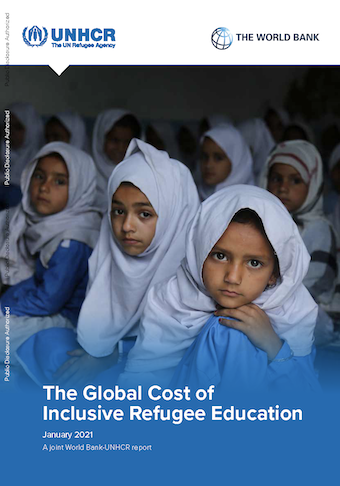The Global Cost of Inclusive Refugee Education

This paper presents a joint effort by the World Bank and UNHCR to estimate the cost of
educating refugee children through host country inclusive systems. This is critical, now
more than ever, with refugees staying much longer in asylum countries, without solutions.
The COVID-19 pandemic has exposed the deep vulnerabilities of the most marginalized
populations, including refugee children.
As data on the impact of COVID-19’s impact on education costs and public expenditure is still evolving, this paper provides a pre-
COVID-19 baseline for the estimated costs of educating all refugee children.
The report reckons that education in emergencies is not only a humanitarian
crisis but also a development crisis with large numbers of refugee children spending their whole
education life cycle in displaced settings. Eighty-five percent of the world’s displaced persons are
hosted in low and lower middle-income countries. These environments are often already stretched to
deliver quality education services. Where refugees are concentrated in border
or rural regions, inclusive education systems can direct resources to previously underserved
areas in host countries. Inclusive national education systems promote a streamlined response
to the large influx of refugees by building resilient systems with benefits for refugees and host
communities alike. It creates a framework for the international community to harmonize efforts
and share the collective burden and responsibility of refugee education.
educating refugee children through host country inclusive systems. This is critical, now
more than ever, with refugees staying much longer in asylum countries, without solutions.
The COVID-19 pandemic has exposed the deep vulnerabilities of the most marginalized
populations, including refugee children.
As data on the impact of COVID-19’s impact on education costs and public expenditure is still evolving, this paper provides a pre-
COVID-19 baseline for the estimated costs of educating all refugee children.
The report reckons that education in emergencies is not only a humanitarian
crisis but also a development crisis with large numbers of refugee children spending their whole
education life cycle in displaced settings. Eighty-five percent of the world’s displaced persons are
hosted in low and lower middle-income countries. These environments are often already stretched to
deliver quality education services. Where refugees are concentrated in border
or rural regions, inclusive education systems can direct resources to previously underserved
areas in host countries. Inclusive national education systems promote a streamlined response
to the large influx of refugees by building resilient systems with benefits for refugees and host
communities alike. It creates a framework for the international community to harmonize efforts
and share the collective burden and responsibility of refugee education.
Year:
Organisation:
UNHCR and World Bank
Keywords:
refugee child; Primary and Secondary Education; attending school; conflict and violence; public expenditure on education
Marginalized & Vulnerable group:
Refugees & Migrants
Topic:
System wide approach
Level of Education:
Across the education sector
Type of Resources:
Research & Policy Papers
Country/Region:
Africa, Asia & the Pacific
Language of Publication:
English